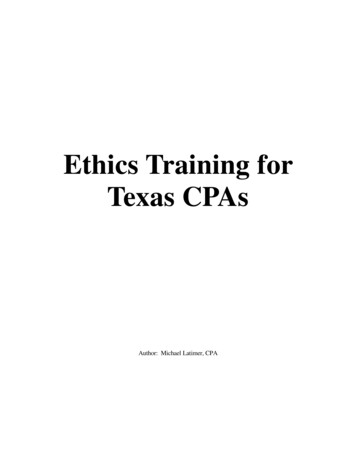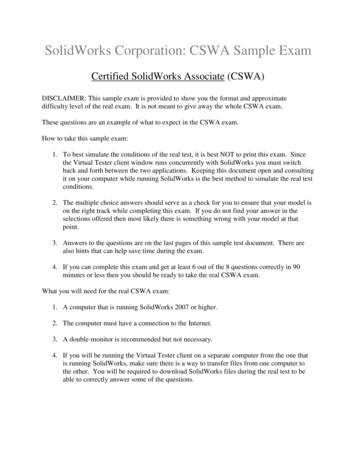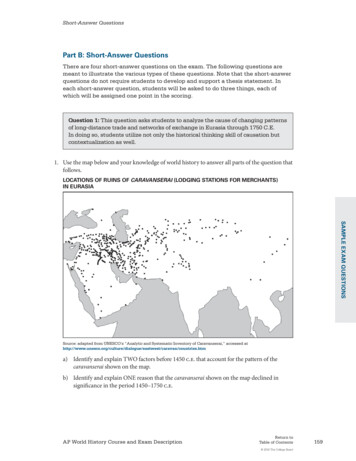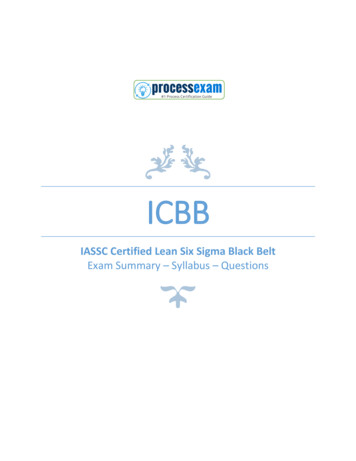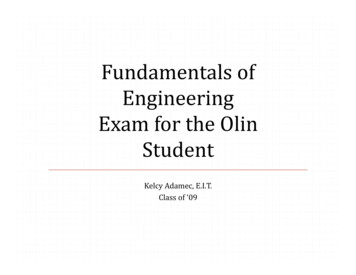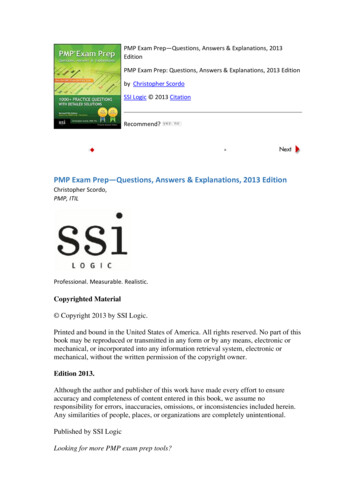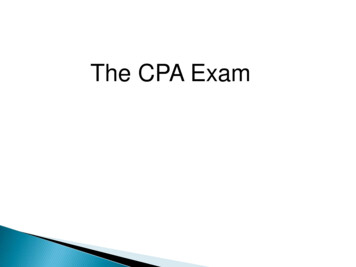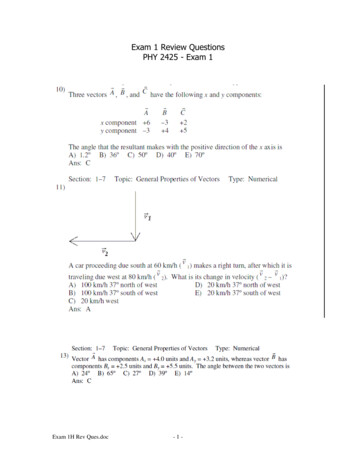
Transcription
Exam 1 Review QuestionsPHY 2425 - Exam 1Exam 1H Rev Ques.doc-1-
Section: 1–7Topic: General Properties of Vectors 1AAGiven vector , the vector 3 A)Ahas a magnitude 3 times that of . B)Apoints in the same direction as .Type: Conceptual Ahas components each of which is 3 times those of . D)Amakes the same angle with a given axis as does .C)E) is described by all of these.Ans: EExam 1H Rev Ques.doc-2-
Section: 1–7Topic: General Properties of Vectors Type: Numerical 2ĵiˆAWhat angle does the vector 5 – 12 make with the positive x axis?A) 67.4º B) 22.6º C) 36.9º D) 53.1º E) 24.6ºAns: ASection: 1–7Topic: General Properties of VectorsType: Conceptual3A velocity vector has an x component of 5.5 m/s and a y component of –3.5 m/s. Thediagram that gives the direction of the vector isA) 1 B) 2 C) 3 D) 4 E) None of these is correct.Ans: BExam 1H Rev Ques.doc-3-
Section: 2–1 Topic: Displacement, Velocity, and Speed Type: Numerical4 A particle moves from x0 30 cm to x –40 cm in 5 s. The average velocity of theparticle during this time interval isA) 2 cm/s. B) –2 cm/s. C) 14 cm/s. D) –14 cm/s. E) –140 cm/s.Ans: DSection: 2–1 Topic: Displacement, Velocity, and Speed Type: Numerical5 You drive for 30 min at 100 km/h and then stop for 15 min. You then drive for 45 minat 80 km/h. Your average speed for the entire trip isA) 73 km/h. B) 83 km/h. C) 88 km/h. D) 90 km/h. E) 97 km/h.Ans: ASection: 2–1 Topic: Displacement, Velocity, and Speed Type: Numerical6 You drive for 30 min for 30 km East and then another 30 min for 40 km North. Youraverage speed for the entire trip isA) 40 km/h. B) 50 km/h. C) 60 km/h. D) 70 km/h. E) 80 km/h.Ans: DSection: 2–1 Topic: Displacement, Velocity, and Speed Type: Numerical7 You drive for 30 min for 30 km East and then another 30 min for 40 km North. Youraverage velocity for the entire trip isA) 40 km/h. B) 50 km/h. C) 60 km/h. D) 70 km/h. E) 80 km/h.Ans: BSection: 2–1 Topic: Displacement, Velocity, and Speed Type: Numerical8 Assume that the Deschutes River has straight and parallel banks and that the current is0.75 m/s. Drifting down the river, you fall out of your boat and immediately grab apiling of the Warm Springs Bridge. You hold on for 40 s and then swim after the boatwith a speed relative to the water of 0.95 m/s. The distance of the boat downstreamfrom the bridge when you catch it isA) 67 m. B) 90 m. C) 78 m. D) 54 m. E) 120 m.Ans: DExam 1H Rev Ques.doc-4-
Section: 2–1 Topic: Displacement, Velocity, and Speed Type: Numerical9 A river 1.00 mile wide flows with a constant speed of 1.00 mi/h. A woman leaves froma point on the river bank. The woman rows a boat 1.00 mi directly upstream and returnsto the starting point. Her speed in still water is 2.00 mi/h. The travel time for thewoman isA) 2.00 h. B) 1.15 h. C) 1.00 h. D) 1.33 h. E) 0.67 h.Ans: DSection: 2–1 Topic: Displacement, Velocity, and Speed Type: Numerical10 A river 1.00 mile wide flows with a constant speed of 1.00 mi/h. A man can row a boatat 2.00 mi/h. He crosses the river in a direction that puts him directly across the riverfrom the starting point, and then he returns in a direction that puts him back at thestarting point in the shortest time possible. The travel time for the man isA) 2.00 h. B) 1.15 h. C) 1.00 h. D) 1.33 h. E) 0.67 h.Ans: BSection: 2–1Topic: Displacement, Velocity, and SpeedType: Numerical11The graph shows the velocity of a particle as a function of time. In the 12 s shown, theparticle travelsA) 0 m. B) 1200 m. C) 640 m. D) 440 m. E) 200 m.Ans: CSection: 2–1 Topic: Displacement, Velocity, and Speed Type: Conceptual12 If an object is moving at uniform speed in a straight line, its instantaneous velocityhalfway through any time interval isA) greater than its average velocity.D) half of its average velocity.B) less than its average velocity.E) twice its average velocity.C) the same as its average velocity.Ans: CExam 1H Rev Ques.doc-5-
Section: 2–1Topic: Displacement, Velocity, and SpeedType: Conceptual13The graph shows how the position of a particle depends on time. Which choice isclosest to the instantaneous speed of the particle at t 3 s?A) 0.40 m/s B) 0.67 m/s C) 0.75 m/s D) 1.50 m/s E) 2.22 m/sAns: ASection: 2–1 Topic: Displacement, Velocity, and Speed Type: Conceptual14 On a graph that shows position on the vertical axis and time on the horizontal axis, astraight line with a positive slope representsA) a constant positive acceleration.D) a constant positive velocity.B) a constant negative acceleration.E) a constant negative velocity.C) zero velocity.Ans: DSection: 2–1 Topic: Displacement, Velocity, and Speed Type: Conceptual15 On a graph that shows position on the vertical axis and time on the horizontal axis, astraight line with a negative slope representsD) a constant positive velocity.A) a constant positive acceleration.B) a constant negative acceleration.E) a constant negative velocity.C) zero velocity.Ans: EExam 1H Rev Ques.doc-6-
Section: 2–1Topic: Displacement, Velocity, and SpeedType: Conceptual16The graph shows the displacement of a particle along the y axis as a function of time.The points at which the velocity is the same areA) A and C. B) A and E. C) B and D. D) A, C, and E. E) B, C, and D.Ans: CSection: 2–1Topic: Displacement, Velocity, and SpeedType: Conceptual17The graph represents the displacement of a particle along the x axis as a function oftime. The interval in which the velocity of this particle is negative isA) a–b B) b–c C) d–e D) c–d E) none of these is correct.Ans: ESection: 2–1 Topic: Displacement, Velocity, and Speed Type: Conceptual18 For this problem, refer to the figure in problem 31. Which point has the highestinstantaneous velocity?A) a B) b C) c D) d E) eAns: AExam 1H Rev Ques.doc-7-
Section: 2–1 Topic: Displacement, Velocity, and Speed Type: Conceptual19 For this problem, refer to the figure in problem 31. Which interval has the highestmagnitude in acceleration?A) a-b B) b-c C) c-d D) d-e E) they have equal accelerationAns: BSection: 2–1Topic: Displacement, Velocity, and SpeedType: Conceptual20In which graph is the particle the farthest from the origin at t 5 s?A) 1 B) 2 C) 3 D) 4 E) 5Ans: ESection: 2–1Topic: Displacement, Velocity, and SpeedType: Conceptual21In which graph is the particle the closest to the origin at t 5 s?A) 1 B) 2 C) 3 D) 4 E) 5Ans: CExam 1H Rev Ques.doc-8-
Section: 2–1Topic: Displacement, Velocity, and SpeedType: Conceptual22An object moves along the x axis as shown in the diagram. At which point or points isthe object instantaneously at rest?A) A and ED) E onlyE) None of these is correct.B) B, D, and EC) C onlyAns: BSection: 2–1 Status: New to 5th editionTopic: Displacement, Velocity, and Speed Type: Numerical23 A Ford truck enters a highway and travels at a uniform speed of 50 mph. Half an hourlater a Jaguar enters the highway at the same junction and heads in the same direction at55 mph. How long after the Ford entered the highway does the Jaguar catch up with thetruck?A) 5.0 hrs B) 6.0 hrs C) 1.0 hrs D) 1.6 hrs E) 5.5 hrsAns: ESection: 2–2 Topic: Acceleration Type: Numerical24 A car accelerates uniformly from rest to a speed of 20 m/s at the end of 1 min; it thenaccelerates uniformly to a speed of 40 m/s at the end of the next minute. During this2-min period, the average speed of the car isA) 7.5 m/s B) 30 m/s C) 15 m/s D) 20 m/s E) 40 m/sAns: DSection: 2–2 Topic: Acceleration Type: Numerical25 An object is moving in a straight line. At t 0, its speed is 5.0 m/s. From t 0 to t 4.0 s, its acceleration is 2.5 m/s2. From t 4.0 s to t 11.0 s, its speed is constant. Theaverage speed over the entire time interval isA) 9.5 m/s B) 15 m/s C) 13 m/s D) 21 m/s E) 8.2 m/sAns: CExam 1H Rev Ques.doc-9-
Section: 2–2 Topic: Acceleration Type: Numerical26 A particle that is moving along a straight line decelerates uniformly from 40 cm/s to 20cm/s in 5.0 s and then has a constant acceleration of 20 cm/s2 during the next 4.0 s. Theaverage speed over the whole time interval isA) 57 cm/s B) 140 cm/s C) 86 cm/s D) 43 cm/s E) 97 cm/sAns: DSection: 2–2 Topic: Acceleration Type: Numerical27 A particle decelerates uniformly from a speed of 30 cm/s to rest in a time interval of 5.0s. It then has a uniform acceleration of 10 cm/s2 for another 5.0 s. The particle movesin the same direction along a straight line. The average speed over the whole timeinterval isA) 20 cm/s B) 35 cm/s C) 38 cm/s D) 100 cm/s E) 12 cm/sAns: ASection: 2–2 Status: New to 5th edition Topic: Acceleration Type: Numerical28 A Lamborghini sports car can accelerate from zero to 60 mph in 4 seconds. It candecelerate from 60 mph to rest in 120 ft. What is the ratio of average acceleration overaverage deceleration? (1 mile 5280 ft)A) 1.74 10 5 B) 1.47 C) 0.682 D) 0.0114 E) 0.688Ans: CSection: 2–2 Status: New to 5th edition Topic: Acceleration Type: Numerical29 If we assume that a spaceship could accelerate from rest at a constant rate of 9.81 m/s2,then how long would it take to reach 1% of the speed of light? (Assume the speed oflight 3.0 108 m/s)A) 1.8 days B) 3.5 days C) 3.1 104 s D) 3.1 106 s E) 7.1 daysAns: BSection: 2–2 Status: New to 5th edition Topic: Acceleration Type: Numerical30 If we assume that a spaceship could accelerate from rest up to 1% of the speed of lightat a constant rate of 9.81 m/s2, how many times the radius of our Solar System (i.e., thedistance from the Sun to Pluto 5.9 109 km) would the spaceship have traveled?A) 78 B) 7.8 10 2 C) 2.6 10 10 D) 2.6 10 7 E) 7.8 10 1Ans: BExam 1H Rev Ques.doc- 10 -
Section: 2–2 Status: New to 5th edition Topic: Acceleration Type: Numerical31 A common statistic in car tests is the standing (starting from rest) quarter-mileperformance. A modern sports car can achieve a terminal speed (speed at the end of thequarter-mile) of 120 mph (193 km/h). How does the average acceleration compare to g?(0.25 mile 402 m)A) 0.36 g B) 2.8 g C) 0.067 g D) 15.0 g E) 0.73 gAns: ASection: 2–2 Status: New to 5th edition Topic: Acceleration Type: Numerical32 A racecar starts from rest and accelerates at a constant rate and reaches a speed of 160km/h (100 mph) in 6.0 seconds. It continues at this speed for another 5 seconds. What isthe car's average speed during the first 11 seconds?A) 34.3 m/s B) 29.3 m/s C) 22.2 m/s D) 32.3 m/s E) 44.4 m/sAns: DSection: 2–2 Status: New to 5th edition Topic: Acceleration Type: Numerical33 A car is traveling at 120 km/h (75 mph). When applied the braking system can stop thecar with a deceleration rate of 9.0 m/s2. The typical reaction time for an alert driver is0.5 s versus 2 s for a sleepy driver. Assuming a typical car length of 5 m, calculate thenumber of additional car lengths it takes the sleepy driver to stop compared to the alertdriver.A) 13 B) 3.0 C) 10 D) 16 E) 26Ans: CSection: 2–3 Topic: Motion with Constant Acceleration Type: Numerical34 A projectile is fired vertically upward with a speed of 62 m/s. In the absence of airresistance, the maximum height the projectile attains isA) 25 km B) 98 m C) 200 m D) 19 km E) 3 mAns: CSection: 2–3 Topic: Motion with Constant Acceleration Type: Numerical35 A ball is dropped from the top of a building. In the absence of air resistance, the ballwill hit the ground with a speed of 49 m/s. The height of the building isA) 25 m B) 5 m C) 240 m D) 120 m E) 10 mAns: DSection: 2–3 Topic: Motion with Constant Acceleration Type: Numerical36 A ball is thrown upward from an 80-ft tower with an initial vertical speed of 40 ft/s. Ifair resistance is ignored, the ball’s speed when it reaches the ground will beA) 67 ft/s B) 1.3 102 ft/s C) 1.2 102 ft/s D) 49 ft/s E) 82 ft/sAns: EExam 1H Rev Ques.doc- 11 -
Section: 2–3 Topic: Motion with Constant Acceleration Type: Numerical37 A balloon is ascending at a rate of 16 ft/s at a height of 32 ft above the ground when apackage is dropped. The time taken, in the absence of air resistance, for the package toreach the ground isA) 1.0 s B) 1.5 s C) 2.0 s D) 2.5 s E) 3.0 sAns: CSection: 2–3 Topic: Motion with Constant Acceleration Type: Numerical38 An object is thrown upward with a velocity of 32 ft/s from a stationary balloon which is48 ft above the ground. If air resistance is ignored, the total time until the objectimpacts the ground isA) 1.0 s B) 2.0 s C) 3.0 s D) 4.0 s E) 6.0 sAns: CSection: 2–3 Status: New to 5th editionTopic: Motion with Constant Acceleration Type: Numerical39 A baseball is thrown vertically up to a height of 30 m on Earth. If the same ball isthrown up on the moon with the same initial speed how much further will it travel up?(Assume gmoon gearth/6)A) 5.0 m B) 25 m C) 12 m D) 180 m E) 150 mAns: ESection: 2–3 Status: New to 5th editionTopic: Motion with Constant Acceleration Type: Numerical40 Two baseballs are thrown vertically up from the ground at the same speed, one on Earth,and one on Mars. The baseball on Earth reaches a maximum height of 25 m. Which ballhits the ground first and by what time difference? (gMars 0.38 gEarth)D) Mars by 3.7 sA) Mars by 7.4 sB) Earth by 7.4 sE) Earth by 2.7 sC) Earth by 3.7 sAns: BSection: 2–3 Status: New to 5th editionTopic: Motion with Constant Acceleration Type: Numerical41 A sandbag is released from a rising air balloon and hits the ground 7 seconds later. Fromwhat height was the sandbag dropped from if at the moment of release the balloon wastraveling upward at 3 m/s.A) 219 m B) 240 m C) 459 m D) 261 m E) 55 mAns: AExam 1H Rev Ques.doc- 12 -
Section: 2–4 Topic: Integration Type: Numerical42 The relationship between the velocity of a body moving along the x axis and time isgiven by v 3t2 – 2t, where the units are SI units. The total distance the body travelsbetween the times t 2 s and t 4 s isA) 12 m B) 60 m C) 48 m D) 34 m E) 44 mAns: ESection: 2–4 Topic: Integration Type: Numerical43 The relationship between the velocity of a body moving along the x axis and time isgiven by v 2t3 2t, where the units are SI units. The total distance the body travelsbetween the times t 2 s and t 4 s isA) 132 m B) 144 m C) 136 m D) 120 m E) 156 mAns: ASection: 2–4Topic: IntegrationType: Numerical44The graph shows the instantaneous velocity of a car during 15 s of its motion. Thedistance traveled by this car during this 15-s interval isA) 80 mm B) 1.2 km C) 600 m D) 400 m E) 200 mAns: DSection: 2–4 Topic: Integration Type: Numerical45 The velocity of a particle is given by v(t) 3t. The average velocity for the particlebetween t 2 and 4 s isA) 4 m/sD) 12 m/sB) 6 m/sE) 18 m/sC) 9 m/sAns: CExam 1H Rev Ques.doc- 13 -
Section: 3–1 Topic: Position, Velocity, and Acceleration Type: Numerical46 You walk 5 km north and then 12 km east. Your resultant displacement isA) 13 km at an angle of 22.6º north of east.B) 13 km at an angle of 67.4º north of east.C) 17 km at an angle of 22.6º north of east.D) 17 km at an angle of 67.4º north of east.E) None of these is correct.Ans: ASection: 3–1 Topic: Position, Velocity, and Acceleration Type: Numerical47 A vector has an x component of –5.51 units and a y component of 9.52 units. Theangle between the positive direction of the vector and the positive direction of the x axisisA) 125º B) 60º C) 120º D) 150º E) –60ºAns: CSection: 3–1 Topic: Position, Velocity, and Acceleration Type: Numerical48 A vector has an x component of 5.51 units and a y component of –9.52 units. The anglebetween the positive direction of the vector and the positive direction of the x axis isapproximatelyA) 30º B) –30º C) 60º D) –60º E) None of these is correct.Ans: DSection: 3–1 Topic: Position, Velocity, and Acceleration Type: Numerical49 The position vector of an object is given by r 2iˆ 3 ˆj and 4 s later, its position vector1 is r2 2iˆ 7 ˆj . The units are in m. The change in the position vector r , in m, isA) 4iˆ 4 ˆjAns: DB) 10 ĵC) 4iˆ 4 ˆjD) 4iˆ 4 ˆjE) None of the aboveSection: 3–1 Topic: Position, Velocity, and Acceleration Type: Numerical50 The position vector of an object is given by r 2iˆ 3 ˆj and 4 s later, its position vector1 ˆˆis r2 2i 7 j . The units are in m. The magnitude of the change in the position vector r isA) 0 m B) 2 2 m C) 4 2 m D) 10 m E) 8 2 mAns: CExam 1H Rev Ques.doc- 14 -
Section: 3–1 Topic: Position, Velocity, and Acceleration Type: Conceptual51 Which of the vector diagrams below best represent the change in position vector from P1to P2? rr1 rr2r1-r2(1)(3) rr2-r1r2r1 r(4)(2)A) (1) B) (2)Ans: DC) (3)D) (4)E) None of these is correct.Section: 3–1 Topic: Position, Velocity, and Acceleration Type: Numerical52 A particle has an initial velocity of 4.8 m/s toward the south and a final velocity of 7.1m/s toward the east. The particle was subject to a constant acceleration for 0.25 s. Themagnitude and the direction of the acceleration must have beenA) 8.6 m/s2 at 34.1º north of eastD) 34 m/s2 at 34.1º south of eastB) 260 m/s2 at 34.1º south of eastE) 8.6 m/s2 at 34.1º south of east2C) 34 m/s at 34.1º north of eastAns: CSection: 3–1 Topic: Position, Velocity, and Acceleration Type: Conceptual53 A river is 0.76 km wide. The banks are straight and parallel. The current is 5.0 km/hand is parallel to the banks. A boat has a maximum speed of 3 km/h in still water. Thepilot of the boat wishes to travel on a straight line from A to B, where AB isperpendicular to the banks. The pilot shouldA) head directly across the river.B) head 68º upstream from the line AB.C) head 22º upstream from the line AB.D) give up. The trip from A to B is not possible with this boat.E) do none of these.Ans: DExam 1H Rev Ques.doc- 15 -
Section: 3–1 Topic: Position, Velocity, and Acceleration Type: Numerical54 A car is traveling east at 50 km/h. It rounds a curve, and 5 s later it is traveling north at50 km/h. The magnitude of the average acceleration of the car isA) zeroD) 50 km/h · sB) 20 km/h · sE) None of these is correct.C) 10 km/h · sAns: ESection: 3–1 Topic: Position, Velocity, and Acceleration Type: Numerical55 A pilot wants the heading of an airplane to be 37º east of north. The wind is from theeast at 37 km/h. The airplane has a speed relative to the air of 370 km/h.Approximately what heading should the pilot maintain? (Hint: Sketch the problemgraphically and select the best answer from the list given.)A) 318º B) 4.6º C) 122º D) 32º E) 42ºAns: ESection: 3–1 Topic: Position, Velocity, and Acceleration Type: Numerical56 A pilot wants the heading of an airplane to be 45º east of north. The wind is from 270ºat 32 km/h, and the speed of the airplane through the air is 320 km/h. The pilot shouldmaintain a heading of approximatelyA) 15º B) 49º C) 41º D) 4º E) 131ºAns: CSection: 3–1 Topic: Position, Velocity, and Acceleration Type: Numerical57 A car is at position (x1, y1) (4 m, 5 m) at time t1 1 s. If 10 seconds later the carmoving in a straight line is at position (x2, y2) (204 m, 305 m), calculate the distancetraveled by the car in this interval.A) 367 m B) 500 m C) 373 m D) 509 m E) 361 mAns: ESection: 3–1 Topic: Position, Velocity, and Acceleration Type: Numerical58 A car is at position (x1, y1) (4 m, 5 m) at time t1 1 s. If 10 seconds later the carmoving in a straight line is at position (x2, y2) (204 m, 305 m), calculate the magnitudeof the average velocity during this interval.A) 36.1 m/s B) 32.8 m/s C) 36.7 m/s D) 50.0 m/s E) 40.1 m/sAns: AExam 1H Rev Ques.doc- 16 -
Section: 3–1 Topic: Position, Velocity, and Acceleration Type: Numerical59 A car is at position (x1, y1) (4 m, 5 m) at time t1 1 s. If 10 seconds later the carmoving in a straight line is at position (x2, y2) (204 m, 305 m), find the (size of the)component of the average velocity along the x-axis.A) 30.0 m/s B) 36.1 m/s C) 20.0 m/s D) 18.2 m/s E) 22.2 m/sAns: CSection: 3–1 Topic: Position, Velocity, and Acceleration Type: Numerical60 A train, starting from rest, accelerates along the platform at a uniform rate of 0.6 m/s2. Apassenger standing on the platform is 5 m away from the door when the train starts topull away and heads toward the door at acceleration of 1.2 m/s2. How far away from thedoor is the passenger after 3 seconds?A) 2.7 m B) 5.4 m C) 0.40 m D) 2.3 m E) 0.90 mAns: DSection: 3–2 Topic: Projectile Motion Type: Numerical61 If a baseball is thrown at an angle of elevation of 30º, its range in the absence of airresistance is less than that of one thrown atA) 0º B) 80º C) 20º D) 55º E) 90ºAns: DSection: 3–2 Topic: Projectile Motion Type: Numerical62 A projectile is fired with an initial speed of 1000 m/s at an angle of 37º above thehorizontal. If air resistance is neglected, the horizontal component of the projectile'svelocity after 20 s is approximatelyA) 600 m/s B) 800 m/s C) 640 m/s D) 40 m/s E) 160 m/sAns: BExam 1H Rev Ques.doc- 17 -
Section: 3–2Topic: Projectile MotionType: Conceptual63 vA ball is thrown horizontally from a cliff with a velocity 0. A graph of theacceleration of the ball versus the distance fallen could be represented by curveA) 1 B) 2 C) 3 D) 4 E) 5Ans: ESection: 3–2 Topic: Projectile Motion Type: Conceptual64 Which of the following statements is not true of a projectile moving near the surface ofthe earth against negligible air resistance?A) The horizontal velocity is constant.B) The vertical acceleration is constant.C) The horizontal displacement is directly proportional to the time of flight.D) The vertical velocity at any given time is independent of the angle of projection.E) The horizontal acceleration is constant.Ans: DSection: 3–2 Topic: Projectile Motion Type: Conceptual65 The maximum horizontal range of a rock which is thrown at the same speed butdifferent angles with the horizon and which lands at a level, H, below the initial leveloccurs when the angle isA) less than 0 B) 0 C) greater than 0 and less than 45 (actual value depends on the value of H)D) 45 E) greater than 45 Ans: CExam 1H Rev Ques.doc- 18 -
Section: 3–2Topic: Projectile Motion Type: Conceptual 66A baseball is thrown with a velocity v at an angle θ with the horizontal. The horizontalcomponent of its velocity in the absence of air resistance isA) v cos θ B) v cos θ – gt C) v2 2gx D) v2 – 2gx E) v sin θ – gtAns: ASection: 3–2 Topic: Projectile Motion Type: Conceptual67 A stone with a mass m is dropped from an airplane that has a horizontal velocity v at aheight h above a lake. If air resistance is neglected, the horizontal distance R from thepoint on the lake directly below the point of release to the point where the stone strikesthe water is given by which formula?A) R v(2h/g)2D)B) R (1/2)gt2C)E) None of these is correct.Ans: DSection: 3–2 Topic: Projectile Motion Type: Numerical68 A plane is flying horizontally at a height of 500 m and a constant speed of 429 km/hwhen an object is projected vertically downward at an initial speed of 35.0 m/s. If airresistance is neglected, the average vertical component of velocity between the object'srelease and its striking the ground isA) 70.0 m/s B) 5.50 103 m/s C) 140 m/s D) 105 m/s E) 35.0 m/sAns: ASection: 3–2 Topic: Projectile Motion Type: Conceptual69 A projectile is shot at an angle of 45º to the horizontal near the surface of Earth but inthe absence of air resistance. When it reaches the highest point of its trajectory, itsspeed is 150 m/s. In a second trial with the same projectile, the initial speed is the samebut the angle is now 37º with the horizontal. At its highest point in this trajectory, thespeed of the projectile would beA) 150 m/s (sin 45º/sin 36º)D) 150 m/s (37/45)B) 150 m/s (cos 37º/cos 45º)E) None of these is correct.C) 150 m/s (sin 37º/sin 45º)Ans: BSection: 3–2 Topic: Projectile Motion Type: Numerical70 A rescue airplane is diving at an angle of 37º below the horizontal with a speed of 250m/s. It releases a survival package when it is at an altitude of 600 m. If air resistance isignored, the horizontal distance of the point of impact from the plane at the moment ofthe package's release isA) 2.80 103 m B) 720 m C) 6.80 103 m D) 420 m E) 5.50 103 mAns: BExam 1H Rev Ques.doc- 19 -
Section: 3–2 Topic: Projectile Motion Type: Numerical71 A particle initially moving at 4.0 m/s along the x axis is uniformly accelerated at 3.0m/s2 along the y axis for 2.0 s. The final speed of the particle isA) –2.0 m/s B) 8.2 m/s C) 6.0 m/s D) 10 m/s E) None of these is correct.Ans: ESection: 3–2 Topic: Projectile Motion Type: Conceptual72 A projectile was fired at 35º above the horizontal. At the highest point in its trajectoryits speed was 200 m/s. If air resistance is ignored, the initial velocity had a horizontalcomponent ofA) zeroD) 200/cos (35º) m/sB) 200 cos (35º) m/sE) 200 m/sC) 200 sin (35º) m/sAns: EUse the following to answer questions 73-75:Section: 3–2 Topic: Projectile Motion Type: Conceptual73 The figure represents the parabolic trajectory of a ball going from A to E in Earthgravity but without air resistance. What is the direction of the acceleration at point B?A) it is up and to the rightD) it is straight downE) The acceleration of the ball is zeroB) it is down and to the leftC) it is straight upAns: DSection: 3–2 Topic: Projectile Motion Type: Conceptual74 The figure represents the parabolic trajectory of a ball going from A to E in Earthgravity but without air resistance. What is the direction of the acceleration at point C?A) it is to the rightD) it is straight downB) it is to the leftE) The acceleration of the ball is zeroC) it is straight upAns: DExam 1H Rev Ques.doc- 20 -
Section: 3–2 Topic: Projectile Motion Type: Conceptual75 The figure represents the parabolic trajectory of a ball going from A to E in Earthgravity but without air resistance. At point C the velocity of the ball isA) a maximum and is directed to the right D) a minimum and is directed to the rightB) directed to the leftE) zeroC) a maximumAns: DSection: 3–2Topic: Projectile MotionType: Conceptual76A projectile is fired horizontally in Earth gravity with an initial speed v0. In the absenceof air resistance, which of the following graphs is representative of the projectile'smotion?A) 1 B) 2 C) 3 D) 4 E) 5Ans: AUse the following to answer question 77:Exam 1H Rev Ques.doc- 21 -
Section: 3–2 Topic: Projectile Motion Type: Conceptual77 The figure represents the parabolic trajectory of a ball going from A to E. What is thespeed at point C compared with that at point A?A) It is greater at C than at AB) It is less at C than at AC) The speeds are identicalD) The speeds are both zeroE) It is not possible to answer this question without more information.Ans: BSection: 3–2 Topic: Projectile Motion Type: Numerical78 A naughty squirrel jumps from a tree limb onto a birdfeeder. The tree limb is 4.5 mabove the ground and the top of the birdfeeder is 1.5 m above the ground. If the squirreljumps horizontally with a velocity of 2.5 m/s then how far away in the horizontaldirection can the bird feeder be for the squirrel to just make it onto the top of the feeder.A) 3.6 m B) 2.0 m C) 2.4 m D) 1.5 m E) 1.4 mAns: BSection: 3–2 Topic: Projectile Motion Type: Numerical79 Mark throws a ball to Daniel with an initial speed of 20 m/s at an angle of 45 degrees. Ifthey are initially 55 m apart, calculate the average speed Daniel has to run to catch theball. (Assume the ball is thrown and caught at the same height. Also assume that Danielstarts to run when the ball is thrown.)A) 19 m/s B) 14 m/s C) 4.9 m/s D) 9.1 m/s E) 2.9 m/sAns: CSection: 3–2 Topic: Projectile Motion Type: Numerical80 A roofing tile slides down a roof and falls off the roof edge 10 m above the ground at aspeed of 6 m/s. The roof makes an angle of 30 degrees to the horizontal. How far fromthe exit point on the roof does the tile land?A) 6.00 m B) 16.0 m C) 11.7 m D) 13.6 m E) 19.2 mAns: CSection: 3–2 Topic: Projectile Motion Type: Numerical81 A projectile is ejected from a 25-m high tower with a velocity of 40 m/s at an angle of30 degrees to the horizontal first on Earth and then on Mars. What is the ratio of thetime taken to hit the ground on Mars compared to Earth? (Assume gMars 0.38gEarth)A) 2.4 B) 2.6 C) 0.38 D) 6.9 E) 1.0Ans: AExam 1H Rev Ques.doc- 22 -
Section: 3–3 Topic: Circular Motion Type: Numerical82 A merry-go-round completes one revolution in 30 s. What is the speed of a rider locatedat a distance 3 m from the center of the merry go-round?A) 0.1 m/sD) 6π m/sE) 30 m/sB) 0.2π m/sC) 2π m/sAns: BSection: 3–3 Topic: Circular Motion Type: Numerical83 A merry-go-round completes one revolution in 40 s. What is the centripetal accelerationof a rider located at a distance 2 m from the center of the merry go-round?D) π2/100 m/s2A) 1m/s24B) 1E) π2 m/s22π m/s4C) π2/200 m/s2Ans: CSection: 3–3 Topic: Circular Motion Type: Conceptual84 A ball is whirled in a horizontal circle of radius r and speed v. The radius is increased to2r keeping the speed of the ball constant. The period of the ball changes by a factor ofA) halfD) threeE) fourB) oneC) twoAns: CExam 1H Rev Ques.doc- 23 -
10 A river 1.00 mile wide flows with a constant speed of 1.00 mi/h. A man can row a boat at 2.00 mi/h. He crosses the river in a direction that puts him directly across the river from the starting point, and then he returns in a direction that puts him back at the starting point in the shortest time


